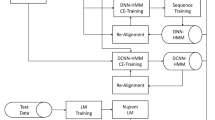Abstract
For on-line handwriting recognition, a hybrid approach that combines the discrimination power of neural networks with the temporal structure of hidden Markov models is presented. Initially, all plausible letter components of an input pattern are detected by using a letter spotting technique based on hidden Markov models. A word hypothesis lattice is generated as a result of the letter spotting. All letter hypotheses in the lattice are evaluated by a neural network character recognizer in order to reinforce letter discrimination power. Then, as a new technique, an island-driven lattice search algorithm is performed to find the optimal path on the word hypothesis lattice which corresponds to the most probable word among the dictionary words. The results of this experiment suggest that the proposed framework works effectively in recognizing English cursive words. In a word recognition test, on average 88.5% word accuracy was obtained.
Similar content being viewed by others
References
A.W. Senior and F. Fallside, “An off-line cursive script recognition system using recurrent error propagation networks,” in Proc. Int. Workshop on Frontiers in Handwriting Recognition, Buffalo, New York, 1993, pp. 132–141.
M. Cote, E. Lecolinet, M. Cheriet, and C.Y. Suen, “Building a perceptron based model for reading cursive script,” in Proc. Int. Conf. on Document Analysis and Recognition, Montreal, Canada, 1995, pp. 898–901.
M.-Y. Chen, A. Kundu, and J. Zhou, “Off-line handwritten word recognition using a hidden Markov model type stochastic network,” IEEE Trans. on SMC, vol. 16,no. 5, pp. 481–496, 1994.
E.J. Bellegarda, J.R. Bellegarda, D. Nahamoo, and K. Nathan, “A probabilistic framework for on-line handwriting recognition,” in Proc. Int. Workshop on Frontiers in Handwriting Recognition, Buffalo, New York, 1993, pp. 225–234.
J.-Y. Ha et al., “Recognition of unconstrained handwritten English words with character and ligature modeling,” Int. Journal of Pattern Recognition and Artificial Intelligence, vol. 9,no. 3, pp. 535–556, 1995.
H. Weissman et al., “Recognition-based segmentation of online run-on handprinted words: Input vs. output segmentation,” Pattern Recognition, vol. 27,no. 3, pp. 405–420, 1994.
M. Gilloux, B. Lemarie, and M. Leroux, “A hybrid radial basis function network/hidden Markov model handwritten word recognition system,” in Proc. Int. Conf. on Document Analysis and Recognition, Montreal, Canada, 1995, pp. 394–397.
G. Zavaliagkos, “A hybrid continuous speech recognition system using segmental neural nets with hidden Markov models,” Int. Journal of Pattern Recognition and Artificial Intelligence, vol. 7,no. 4, pp. 647–667, 1993.
R.G. Casey and E. Lecolinet, “Strategies in character segmentation: A survey,” in Proc. Int. Conf. on Document Analysis and Recognition, Montreal, Canada, 1995, pp. 1028–1033.
F.R. Chen, L.D. Wilcox, and D.S. Bloomberg, “Word spotting in scanned images using hidden Markov models,” in Proc. Int. Conf. on Acoustics, Speech and Signal Processing, 1993, pp. 1–4.
M. Cheriet and C.Y. Suen, “Extraction of key letters for cursive script recognition,” Pattern Recognition Letters, vol. 14, pp. 1009–1017, 1993.
G.D. Forney, “The Viterbi algorithm,” in Proc. IEEE, pp. 268–278, 1973.
N. Morgan, H. Bourland, and S. Renals, “Hybrid neural network/hidden Markov model systems for continuous speech,” Int. Journal of Pattern Recognition and Artificial Intelligence, vol. 7,no. 4, pp. 899–916, 1993.
H. Ney, “A comparative study of two search strategies for connected word recognition: Dynamic programming and heuristic search,” IEEE Trans. on PAMI, vol. 14,no. 5, pp. 586–595, 1992.
H.-L. Teuling and L.R.B. Schomaker, “A handwriting recognition system based on the properties and architectures of the human motor system,” in Proc. Int. Workshop on Frontiers in Handwriting Recognition, Montreal, Canada, 1990, pp. 195–209.
A. Corazza et al., “Computation of probabilities for an island-driven parser,” IEEE Trans. on PAMI, vol. 13,no. 9, pp. 937–949, 1991.
M.P. Marcus, B. Santorini, and M.A. Marcinkiewicz, “Building a large annotated corpus of English: The Penn Treebank,” Computational Linguistics, vol. 19,no. 2, pp. 313–330, 1993.
Y.S. Huang and C.Y. Suen, “Combination of multiple classifiers with measurement values,” in Proc. Int. Conf. on Document Analysis and Recognition, Montreal, Tsukuba Science City, Japan, 1993, pp. 598–601.
R.K. Powalka, N. Sherkat, and R.J. Whitrow, “Recognizer characterisation for combining handwriting recognition results at word level,” in Proc. Int. Conf. on Document Analysis and Recognition, Montreal, Canada, 1995, pp. 68–73.
Author information
Authors and Affiliations
Rights and permissions
About this article
Cite this article
Lee, SH., Kim, J.H. Augmenting the Discrimination Power of HMM by NN for On-Line Cursive Script Recognition. Applied Intelligence 7, 305–314 (1997). https://doi.org/10.1023/A:1008261419981
Issue Date:
DOI: https://doi.org/10.1023/A:1008261419981




